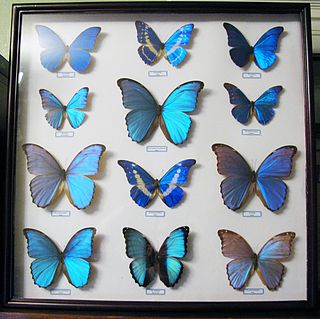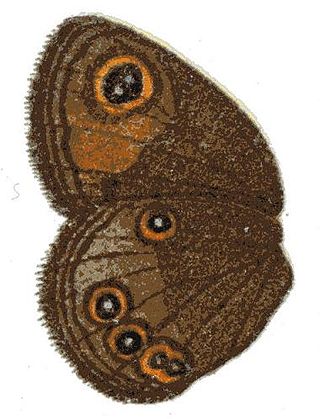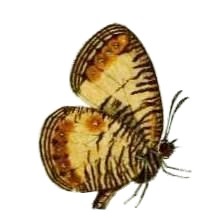
Danainae is a subfamily of the family Nymphalidae, the brush-footed butterflies. It includes the Daniadae, or milkweed butterflies, who lay their eggs on various milkweeds on which their larvae (caterpillars) feed, as well as the clearwing butterflies (Ithomiini), and the tellervini.

The Nymphalidae are the largest family of butterflies, with more than 6,000 species distributed throughout most of the world. Belonging to the superfamily Papilionoidea, they are usually medium-sized to large butterflies. Most species have a reduced pair of forelegs and many hold their colourful wings flat when resting. They are also called brush-footed butterflies or four-footed butterflies, because they are known to stand on only four legs while the other two are curled up; in some species, these forelegs have a brush-like set of hairs, which gives this family its other common name. Many species are brightly coloured and include popular species such as the emperors, monarch butterfly, admirals, tortoiseshells, and fritillaries. However, the under wings are, in contrast, often dull and in some species look remarkably like dead leaves, or are much paler, producing a cryptic effect that helps the butterflies blend into their surroundings.

The superfamily Papilionoidea contains all the butterflies except for the moth-like Hedyloidea.

The Satyrinae, the satyrines or satyrids, commonly known as the browns, are a subfamily of the Nymphalidae. They were formerly considered a distinct family, Satyridae. This group contains nearly half of the known diversity of brush-footed butterflies. The true number of the Satyrinae species is estimated to exceed 2,400.

The Satyrini is one of the tribes of the subfamily Satyrinae. It includes about 2200 species and is therefore the largest tribe in the subfamily which comprises 2500 species.

The Morphinae are a subfamily of Nymphalidae butterflies that includes the morphos, the owl butterflies (Caligo), and related lineages. It is either considered a sister group of the Satyrinae, or disassembled and included therein.
Anthene contrastata, the mashuna hairtail, is a butterfly of the family Lycaenidae. It is found in eastern Africa, from South Africa, north to Ethiopia and Arabia.

Mashuna is a butterfly genus from the subfamily Satyrinae in the family Nymphalidae.
Mashuna upemba is a butterfly in the family Nymphalidae. It is found in north-eastern Angola, the Democratic Republic of the Congo and south-western Tanzania. The habitat consists of marshy areas and open, grassy glades at high altitudes.
Neocoenyra cooksoni is a butterfly in the family Nymphalidae first described by Herbert Druce in 1907. It is found in the Democratic Republic of the Congo, northern Zambia, Angola and north-western Tanzania. The habitat consists of Brachystegia woodland.

Neocoenyra duplex is a butterfly in the family Nymphalidae. It is found in southern Ethiopia, Somalia, Kenya, Uganda, Rwanda, the eastern part of the Democratic Republic of the Congo and northern Tanzania. The habitat consists of grassy savanna.
Neocoenyra fuligo is a butterfly in the family Nymphalidae. It is found in central Tanzania. The habitat consists of montane grassland at altitudes between 2,000 and 2,100 meters.

Neocoenyra fulleborni is a butterfly in the family Nymphalidae. It is found in southern Tanzania. The habitat consists of submontane and montane grassland and shrubland at altitudes between 1,500 and 1,800 meters.
Neocoenyra kivuensis is a butterfly in the family Nymphalidae. It is found in the eastern part of the Democratic Republic of the Congo, Burundi, western Tanzania, Zambia and Malawi. The habitat consists of Brachystegia woodland, montane grassland on forest margins, at altitudes between 1,000 and 2,000 meters.
Neocoenyra petersi is a butterfly in the family Nymphalidae. It is found in southern Tanzania. The habitat consists of montane grassland at altitudes between 2,550 and 2,800 meters.
Physcaeneura jacksoni is a butterfly in the family Nymphalidae. It is found in north-eastern Tanzania.

Physcaeneura leda is a butterfly in the family Nymphalidae. It is found along the coast of Kenya, as well as in north-eastern Tanzania and southern Somalia. The habitat consists of dense woodland, forest margins and grassy forest clearings from sea-level to 1,850 meters.

Physcaeneura pione, the light webbed ringlet, is a butterfly in the family Nymphalidae. It is found in north-eastern and western Tanzania, the Democratic Republic of the Congo, northern Zambia, Malawi, western Mozambique and eastern Zimbabwe. The habitat consists of moist savanna.
Pseudonympha arnoldi, or Arnold's brown, is a butterfly in the family Nymphalidae. It is found in north-eastern Zimbabwe. The habitat consists of damp spots in montane grassland.
Lepidochrysops mashuna, the mashuna blue, is a butterfly in the family Lycaenidae. It is found in Zimbabwe. Their habitat consists of grassy areas in savanna. Adults feed from flowers. They are on wing from October to December.










